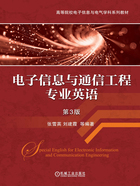
1.1 科技英语语法的特点
科技英语的语法具有以下4个特点。
1)多使用现在时和被动语态。由于科技文体描述的都是一般的客观真理、事物、过程和现象等,因此主语多为非人称代词。使用现在时和被动语态,在一定程度上提高了科技文体的客观性。如:
The signal levels inside power amplifiers are so much larger than these weak inputs that even the slightest “leakage” from the output back to the input may cause problem.
功率放大器中的信号幅度比微弱的输入信号大得多,即使输出中极微小的泄漏传输到输入端都会引发问题。
2)多使用带有介词短语、形容词短语、分词短语、不定式短语、同位语从句、定语从句、状语从句等修饰语的长句。当阅读科技文体时,往往会遇到一个句子长达七八行,甚至整段文字是由一个英语长句构成的现象。
3)科技英语中常常用两种语气,即虚拟语气和祈使语气。虚拟语气在科技英语中用来描述假设的条件,即假设有某种条件,就会产生某种结果。在公式化表达或不强调动作的执行者时常用祈使语气。如:
①If there were no attraction between the proton and the electron, the electron would fly away from the proton in a straight line.
倘若质子和电子之间不存在引力,电子就会沿直线飞离质子。
②Suppose f(x) is a periodic continuous function.
设f(x)是周期连续函数。
4)普遍使用能表示动作或状态的抽象名词或起名词功用的非限定动词,即名词化倾向。科技英语的名词化倾向是与科技文体的基本要求密切相关的。科技文体的任务是叙述事实和论证推断,要求言简意赅,表达客观,内容确切,这就要求语言结构的简化,而名词化正好有助于这几点的实现。名词化可以把句子变成短语,可使复合句变成简单句。如:
①Using of neural models can make simulation and optimization process less time-consuming, shifting much computation from on-line optimization to off-line training.
采用神经网络建模可节省仿真和优化的时间,将在线优化转为离线训练。
②Considering the fact that the activation functions of the neurons in the output layer are linear, we are trying to solve the problem with system of linear equations.
因为输出层中神经元的激活函数是线性的,所以我们尝试用线性方程组来求解该问题。